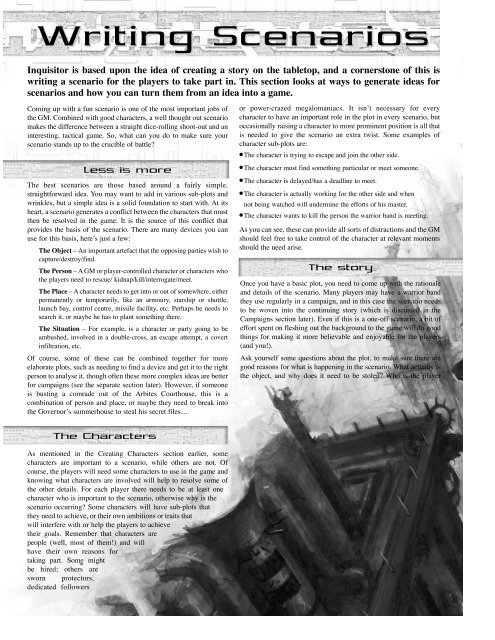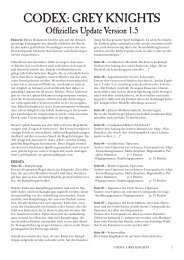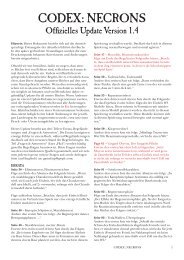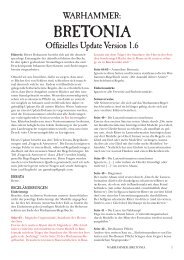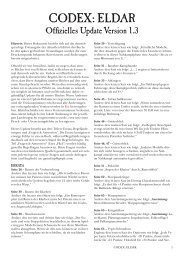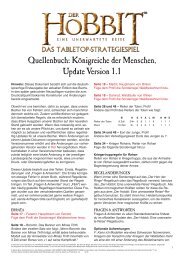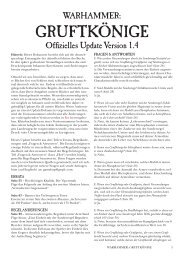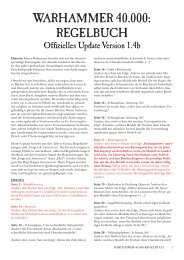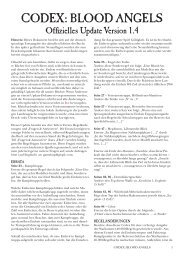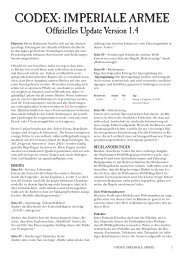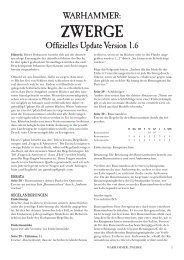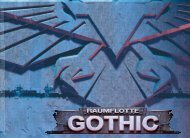Warhammer 40k - Inquisitor - The Living Rule Book 1.1 (Part II).
Warhammer 40k - Inquisitor - The Living Rule Book 1.1 (Part II).
Warhammer 40k - Inquisitor - The Living Rule Book 1.1 (Part II).
You also want an ePaper? Increase the reach of your titles
YUMPU automatically turns print PDFs into web optimized ePapers that Google loves.
Writing Scenarios<br />
<strong>Inquisitor</strong> is based upon the idea of creating a story on the tabletop, and a cornerstone of this is<br />
writing a scenario for the players to take part in. This section looks at ways to generate ideas for<br />
scenarios and how you can turn them from an idea into a game.<br />
Coming up with a fun scenario is one of the most important jobs of<br />
the GM. Combined with good characters, a well thought out scenario<br />
makes the difference between a straight dice-rolling shoot-out and an<br />
interesting, tactical game. So, what can you do to make sure your<br />
scenario stands up to the crucible of battle?<br />
Less is more<br />
<strong>The</strong> best scenarios are those based around a fairly simple,<br />
straightforward idea. You may want to add in various sub-plots and<br />
wrinkles, but a simple idea is a solid foundation to start with. At its<br />
heart, a scenario generates a conflict between the characters that must<br />
then be resolved in the game. It is the source of this conflict that<br />
provides the basis of the scenario. <strong>The</strong>re are many devices you can<br />
use for this basis, here’s just a few:<br />
<strong>The</strong> Object – An important artefact that the opposing parties wish to<br />
capture/destroy/find.<br />
<strong>The</strong> Person – A GM or player-controlled character or characters who<br />
the players need to rescue/ kidnap/kill/interrogate/meet.<br />
<strong>The</strong> Place – A character needs to get into or out of somewhere, either<br />
permanently or temporarily, like an armoury, starship or shuttle,<br />
launch bay, control centre, missile facility, etc. Perhaps he needs to<br />
search it, or maybe he has to plant something there.<br />
<strong>The</strong> Situation – For example, is a character or party going to be<br />
ambushed, involved in a double-cross, an escape attempt, a covert<br />
infiltration, etc.<br />
Of course, some of these can be combined together for more<br />
elaborate plots, such as needing to find a device and get it to the right<br />
person to analyse it, though often these more complex ideas are better<br />
for campaigns (see the separate section later). However, if someone<br />
is busting a comrade out of the Arbites Courthouse, this is a<br />
combination of person and place, or maybe they need to break into<br />
the Governor’s summerhouse to steal his secret files…<br />
<strong>The</strong> Characters<br />
As mentioned in the Creating Characters section earlier, some<br />
characters are important to a scenario, while others are not. Of<br />
course, the players will need some characters to use in the game and<br />
knowing what characters are involved will help to resolve some of<br />
the other details. For each player there needs to be at least one<br />
character who is important to the scenario, otherwise why is the<br />
scenario occurring? Some characters will have sub-plots that<br />
they need to achieve, or their own ambitions or traits that<br />
will interfere with or help the players to achieve<br />
their goals. Remember that characters are<br />
people (well, most of them!) and will<br />
have their own reasons for<br />
taking part. Some might<br />
be hired; others are<br />
sworn protectors,<br />
dedicated followers<br />
or power-crazed megalomaniacs. It isn’t necessary for every<br />
character to have an important role in the plot in every scenario, but<br />
occasionally raising a character to more prominent position is all that<br />
is needed to give the scenario an extra twist. Some examples of<br />
character sub-plots are:<br />
● <strong>The</strong> character is trying to escape and join the other side.<br />
● <strong>The</strong> character must find something particular or meet someone.<br />
● <strong>The</strong> character is delayed/has a deadline to meet.<br />
● <strong>The</strong> character is actually working for the other side and when<br />
not being watched will undermine the efforts of his master.<br />
● <strong>The</strong> character wants to kill the person the warrior band is meeting.<br />
As you can see, these can provide all sorts of distractions and the GM<br />
should feel free to take control of the character at relevant moments<br />
should the need arise.<br />
<strong>The</strong> story<br />
Once you have a basic plot, you need to come up with the rationale<br />
and details of the scenario. Many players may have a warrior band<br />
they use regularly in a campaign, and in this case the scenario needs<br />
to be woven into the continuing story (which is discussed in the<br />
Campaigns section later). Even if this is a one-off scenario, a bit of<br />
effort spent on fleshing out the background to the game will do good<br />
things for making it more believable and enjoyable for the players<br />
(and you!).<br />
Ask yourself some questions about the plot, to make sure there are<br />
good reasons for what is happening in the scenario. What actually is<br />
the object, and why does it need to be stolen? Who is the player


